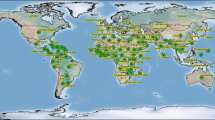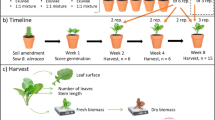Abstract
Leaf trichome variation was studied in a population of Wigandia urens (Hydrophyllaceae) in relation to water availability, diversity of herbivorous insects, and grazing rates. Plants of W. urens have glandular and urticant (stinging hairs) trichomes, and it is possible to distinguish two types of leaves: “smooth” leaves with only glandular trichomes and “bristly” leaves with both types of trichomes. Density of urticant trichomes was negatively correlated with weekly mean precipitation. Fourteen species of insects in five different orders feed on leaves of W. urens throughout the year. Grazing rates varied according to type and age of leaves. Grazing rates were lower in smooth than bristly young leaves but the rates were similar for mature leaves. Secondary metabolites, screened using qualitative methods, showed similar classes of compounds in both types of leaves. Bristly leaves had significantly higher concentrations of nitrogen, phosphorous and water and these nutritional differences were well correlated with the differences in grazing rates between bristly and smooth leaves.
Similar content being viewed by others
References
Benedict JH, Leigh TF, Hyer AH (1983) Lygus hesperus (Heteroptera: Miridae) oviposition behavior, growth, and survival in relation to cotton trichome density. Environ Entomol 12:331–335
Broersma DB, Bernard RL, Luckmann WH (1972) Some effects of soybean pubescence on populations of the potato leafhopper. J Econ Entomol:65:78–82
Cano-Santana Z (1987) Ecología de la relación entre Wigandia urens (Hydrophyllaceae) y sus herbivoros en el Pedregal de San Angel, D.F. (México). Tesis Profesional, Facultad de Ciencias, UNAM, México
Carbajal-Moreno T (1975) Estudio ecológico de los insectos que viven en Wigandia caracasana H.B.K. de una zona del Pedregal de San Angel, D.F. Tesis Profesional, Facultad de Ciencias, UNAM, México
Denno RF, McClure MS (eds) (1983) Variable plants and herbivores in natural and managed systems. Academic Press, London New York
Domínguez XA (1973) Métodos de investigación fitoquímica. Ed. Limusa, México
Ehleringer PJ (1982) The influence of water stress and temperature on leaf pubescence development in Encelia farinosa. Am J Bot 69:670–675
Ehleringer PJ (1984) Ecology and ecophysiology of leaf pubescence in North American desert plants. In: Rodríguez E, Healy PL, Mehta I (eds) Biology and chemistry of plant trichomes. Plenum Press, New York, pp 113–132
Ehleringer PJ, Björkman O (1978) Pubescence and leaf spectral characteristics in a desert shrub, Encelia farinosa. Oecologia 36:151–162
Ehleringer PJ, Björkman O, Mooney HA (1976) Leaf pubescence: effects on absorptance and photosynthesis in a desert shrub. Science 192:376–377
Feeny P (1970) Seasonal changes in oak leaf tannins and nutrients as a cause of spring feeding by winter moth caterpillars. Ecology 15:565–581
Gilbert L (1971) Butterfly-plant coevolution: has Passiflora adenopada won the selectional race with Heliconiine butterflies? Science 172:585–586
Gómez F, Quijano L, Calderón JS, Rios T (1980) Terpenoids isolated from Wigandia kunthii. Phytochemistry 19:2202–2203
Johnson B (1953) The injurious effects of the hooked epidermal hairs of french beans (Phaseolus vulgaris L.) on Aphis caccivora Koch. Bull Entomol Res 44:779–788
Johnson HB (1975) Plant pubescence: an ecological perspective. Bot Rev 41:233–258
Kelsey RG, Reynolds GW, Rodríguez E (1984) The chemistry of biologically active constituents secreted and stored in plant glandular trichomes. In: Rodríguez E, Healey PL, Mehta I (eds) Biology and chemistry of plant trichomes. Plenum Press, New York, pp 187–241
Kraft SJ, Denno RF (1982) Feeding responses of adapted and non-adapted insects to the defensive properties of Baccharis halimifolia L. (Compositae). Oecologia 52:156–163
Levin DA (1973) The role of trichomes in plant defense. Quart Rev Biol 48:3–15
Lukefahr MJ, Cowan CB Jr, Bariola LA, Houghtaling JE (1968) Cotton strains resistance to the cotton fleahopper. J Econ Entomol 61:661–664
McKenzie HA, Wallace HS (1954) The Kjeldhal determination of nitrogen: a critical study of digestion conditions, temperature, catalyst, and oxydizing agent. Aust J Chem 7:55–70
Nash DL (1979) Hydrophyllaceae. In: Gómez-Pompa A (ed) Flora de Veracruz, fascículo 5. INIREB, Xalapa, Veracruz, México
Ochoa GS (1976) La familia Hydrophyllaceae en el Valle de México. Tesis Profesional. Escuela Nacional de Ciencias Biológicas, IPN, México
Poole RW (1974) An Introduction to quantitative ecology. McGraw Hill, New York
Poos FW, Smith FF (1931) A comparison of oviposition and nymphal development of Empoasca fabae (Harris) on different host plants. J Econ Entomol 24:361–371
Raupp MJ, Denno RF (1983) Leaf age as a predictor of herbivore distribution and abundance. In: Denno RF, McClure MS (eds) Variable plants and herbivores in natural and managed systems. Academic Press, London New York, pp 91–124
Rodríguez E (1983) Cytotoxic and insecticide chemicals of desert plants. In: Hedin P (ed) Plant resistance to insects. American Chemical Society, Washington, pp 291–302
Rodríguez E, Healey P, Mehta I (eds) (1984) Biology and chemistry of plant trichomes. Plenum Press, New York
Rzedowski J (1954) Vegetación del Pedregal de San Angel (D.F. México). An Esc Cien Biol I.P.N. Méx 8:59–129
Scriber JM, Slansky F Jr (1981) The nutritional ecology of immature insects. Ann Rev Entomol 26:183–211
Snedecor GW, Cochran WG (1967) Statistical methods. Iowa State University Press, Ames, Iowa
Starks KJ, Merkle OG (1977) Low level resistance in wheat to greenbug. J Econ Entomol 70:305–306
Stephens SG (1959) Laboratory studies of feeding and oviposition preferences of Anthonomus grandis Boh. J Econ Entomol 52:390–396
Stipanovic RD (1983) Function and chemistry of plant trichomes and glands in insect resistance. In: Hedin PA (ed) Plant resistance to insects. American Chemical Society, Washington DC, pp 69–100
Technicon Industrial Systems (TIS) (1977a) Industrial method No. 334-74 W.B. Individual simultaneous determination of nitrogen and/or phosphorous in BD acid digest.
Technicon Industrial Systems (TIS) (1977b) Industrial method No. 369-75 A/B. Digestion and sample preparation for the analysis of total Kjeldhal nitrogen and/or total phosphorous in food and agricultural products using the Technicon BD-20 block digestor
Thurston LE (1970) Toxicity of trichomes exudates of Nicotiana and Petunia species to tobacco hornworm larvae. J Econ Entomol 63:272–274
Thurston LE, Lersten VR (1969) The morphology and toxicology of plant stinging hairs. Bot Rev 35:393–412
Whitham TG (1981) Individual trees as heterogeneous environments: adaptation to herbivory or epigenetic noise?. In: Denno RF, Dingle H (eds) Insect life-history patterns: habitat and geographic variation. Springer-Verlag, Berlin New York, pp 9–27
Whitham TG (1983) Host manipulation of parasites: within-plant variation as a defense against rapidly evolving pests. In Denno RF, McClure MS (eds) Variable plants and herbivores in natural and managed systems. Academic Press, London New York, pp 15–41
Whitham TG, Slobodchikoff CN (1981) Evolution by individuals, plant-herbivore interactions, and mosaics of genetic variability: the adaptive significance of somatic mutations in plants. Oecologia 49:287–292
Wolfenburger DA, Sleesman JP (1963) Variation in susceptibility of soybean pubescent types, broad bean, and runner bean varieties and plant introductions to the potato leafhopper. J Econ Entomol 56:895–897
Zar JH (1974) Biostatistical analysis. Prentice-Hall, Inc, Englewood Cliffs, NJ
Author information
Authors and Affiliations
Rights and permissions
About this article
Cite this article
Cano-Santana, Z., Oyama, K. Variation in leaf trichomes and nutrients of Wigandia urens (Hydrophyllaceae) and its implications for herbivory. Oecologia 92, 405–409 (1992). https://doi.org/10.1007/BF00317467
Received:
Accepted:
Issue Date:
DOI: https://doi.org/10.1007/BF00317467




